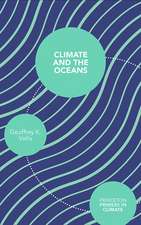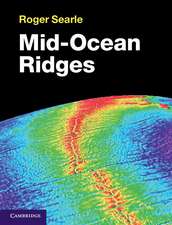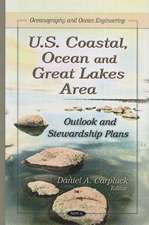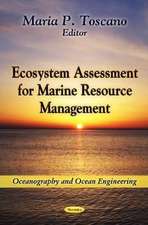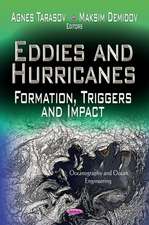21st Century Maritime Silk Road: A Peaceful Way Forward: Springer Oceanography
Autor Chongwei Zheng, Ziniu Xiao, Wen Zhou, Xiaobin Chen, Xuan Chenen Limba Engleză Hardback – 16 mai 2018
This book is one of the series publications on the 21st century Maritime Silk Road (shortened as “Maritime Silk Road”). This series publications cover the characteristics of the marine environment and marine new energy, remote islands and reefs construction, climate change, early warning of wave disasters, legal escort, marine environment and energy big data construction, etc. contributing to the safe and efficient construction of the Maritime Silk Road. It aims to improve our knowledge of the ocean, thus to improve the capacity for marine construction, enhance the viability of remote islands and reefs, ease the energy crisis and protect the ecological environment, improve the quality of life of residents along the Maritime Silk Road, and protect the rights, interests of the countries and regions participating in the construction of the Maritime Silk Road. It will be a valuable reference for decision-makers, researchers, and marine engineers working in the related fields.
| Toate formatele și edițiile | Preț | Express |
|---|---|---|
| Paperback (1) | 885.33 lei 43-57 zile | |
| Springer Nature Singapore – 10 ian 2019 | 885.33 lei 43-57 zile | |
| Hardback (1) | 891.33 lei 43-57 zile | |
| Springer Nature Singapore – 16 mai 2018 | 891.33 lei 43-57 zile |
Din seria Springer Oceanography
- 15%
 Preț: 638.43 lei
Preț: 638.43 lei - 18%
 Preț: 988.37 lei
Preț: 988.37 lei - 24%
 Preț: 1199.75 lei
Preț: 1199.75 lei - 18%
 Preț: 952.89 lei
Preț: 952.89 lei - 20%
 Preț: 572.65 lei
Preț: 572.65 lei - 15%
 Preț: 649.87 lei
Preț: 649.87 lei - 18%
 Preț: 1115.77 lei
Preț: 1115.77 lei - 18%
 Preț: 803.53 lei
Preț: 803.53 lei - 15%
 Preț: 647.27 lei
Preț: 647.27 lei - 18%
 Preț: 939.62 lei
Preț: 939.62 lei - 18%
 Preț: 726.37 lei
Preț: 726.37 lei - 18%
 Preț: 783.20 lei
Preț: 783.20 lei - 18%
 Preț: 778.45 lei
Preț: 778.45 lei - 24%
 Preț: 728.84 lei
Preț: 728.84 lei - 18%
 Preț: 888.97 lei
Preț: 888.97 lei - 18%
 Preț: 945.92 lei
Preț: 945.92 lei - 18%
 Preț: 776.57 lei
Preț: 776.57 lei - 18%
 Preț: 724.00 lei
Preț: 724.00 lei - 15%
 Preț: 694.55 lei
Preț: 694.55 lei
Preț: 891.33 lei
Preț vechi: 1086.99 lei
-18% Nou
Puncte Express: 1337
Preț estimativ în valută:
170.56€ • 178.52$ • 141.96£
170.56€ • 178.52$ • 141.96£
Carte tipărită la comandă
Livrare economică 31 martie-14 aprilie
Preluare comenzi: 021 569.72.76
Specificații
ISBN-13: 9789811079764
ISBN-10: 9811079765
Pagini: 207
Ilustrații: XXI, 170 p. 49 illus., 48 illus. in color.
Dimensiuni: 155 x 235 x 18 mm
Greutate: 0.45 kg
Ediția:1st ed. 2018
Editura: Springer Nature Singapore
Colecția Springer
Seria Springer Oceanography
Locul publicării:Singapore, Singapore
ISBN-10: 9811079765
Pagini: 207
Ilustrații: XXI, 170 p. 49 illus., 48 illus. in color.
Dimensiuni: 155 x 235 x 18 mm
Greutate: 0.45 kg
Ediția:1st ed. 2018
Editura: Springer Nature Singapore
Colecția Springer
Seria Springer Oceanography
Locul publicării:Singapore, Singapore
Cuprins
Introduction to the 21st century Maritime Silk Road.- Wind Climate Characteristics.- Wave Climate Characteristics.- Ocean Current Characteristics.- Marine resource Characteristics and Current Utilization.- Characteristics of Important Routes, Channels, and Ports.- Maritime Silk Road in the Perspective of International Law.- Construction of Comprehensive Application Platform of the Maritime Silk Road.
Notă biografică
Dr. Chong-wei Zheng is the creator and organizer of Marine Resources and Environment Research Group on the Maritime Silk Road. His research interests focus on Physical Oceanography, Marine New Energy Evaluation and Climate Change. He has published more than 90 papers in many peer-reviewed journals as the first author, covering more than 20 papers indexed by SCI or EI (including the high impact journals such as Applied Energy, Renewable and Sustainable Energy Reviews, Ocean Engineering, etc.), as well as more than 60 published in Chinese core periodicals and 4 books. He is the invited reviewer of more than 30 high impact journals.
Prof. Xiao Zi-niu is the director of the State Key Laboratory of Numerical Modeling for Atmospheric Sciences and Geophysical Fluid Dynamics (LASG), Institute of Atmospheric Physics, Chinese Academy of Sciences. He is the Chief Scientist of the National Basic Research Program of China Program (No. 2012CB957800). His research fields cover climate change, the Asian monsoon, and solar impacts on the climate system. He has published more than 20 papers in many peer-reviewed journals in the last 2 years. He has won six National or Provincial Science and Technology Awards.
Dr. Zhou Wen is currently Associate Professor in the School of Energy and Environment, City University of Hong Kong. Her research centers on the East Asian monsoon climate, tropical intraseasonal oscillation, and different types of El Niño and their effects on climate. She aims to understand the variability and predictability of the East Asian winter/summer monsoon, and to detect and attribute climate variability and climate extremes over the Asia-Pacific region. She also looks into natural hazards such as floods/droughts, cold surges and heat waves, and sea level rise / storm surges over the Asia-Pacific region and their relationship with different climate drivers in both present and future scenarios. She has published about 130 SCI papers.
Mr. Chen Xiao-bin graduated in 2008 with a Bachelor of Environmental Engineering degree from the PLA University of Science & Technology, and he obtained his Master’s degree in Meteorology from the College of Meteorology and Oceanography at the PLA University of Science & Technology in 2013. He has published about 10 papers. He participated a book titled “Ocean Environment Characteristic and Wave Energy Resource In the China Sea and Adjacent Waters” which carries out the research on the wind climate, wave climate and wave energy in the offshore waters of China.
Mr. Chen Xuan is a member of Marine Environment and Resources Research Group on the Maritime Silk Road. He has published about 30 papers as the main author or co-author, covering statistics, physical oceanography, and oceanic numerical simulation. In 2017, he and his co-author proposed a new statistical method known as a more general linear regression, a method that sets the field as factors; he and his co-authors described a relationship between the FNP (function of northern pressure gratitude) and equatorial undercurrent; he and his co-authors took the open boundary conditions in the geographical current diagnostics.
Prof. Xiao Zi-niu is the director of the State Key Laboratory of Numerical Modeling for Atmospheric Sciences and Geophysical Fluid Dynamics (LASG), Institute of Atmospheric Physics, Chinese Academy of Sciences. He is the Chief Scientist of the National Basic Research Program of China Program (No. 2012CB957800). His research fields cover climate change, the Asian monsoon, and solar impacts on the climate system. He has published more than 20 papers in many peer-reviewed journals in the last 2 years. He has won six National or Provincial Science and Technology Awards.
Dr. Zhou Wen is currently Associate Professor in the School of Energy and Environment, City University of Hong Kong. Her research centers on the East Asian monsoon climate, tropical intraseasonal oscillation, and different types of El Niño and their effects on climate. She aims to understand the variability and predictability of the East Asian winter/summer monsoon, and to detect and attribute climate variability and climate extremes over the Asia-Pacific region. She also looks into natural hazards such as floods/droughts, cold surges and heat waves, and sea level rise / storm surges over the Asia-Pacific region and their relationship with different climate drivers in both present and future scenarios. She has published about 130 SCI papers.
Mr. Chen Xiao-bin graduated in 2008 with a Bachelor of Environmental Engineering degree from the PLA University of Science & Technology, and he obtained his Master’s degree in Meteorology from the College of Meteorology and Oceanography at the PLA University of Science & Technology in 2013. He has published about 10 papers. He participated a book titled “Ocean Environment Characteristic and Wave Energy Resource In the China Sea and Adjacent Waters” which carries out the research on the wind climate, wave climate and wave energy in the offshore waters of China.
Mr. Chen Xuan is a member of Marine Environment and Resources Research Group on the Maritime Silk Road. He has published about 30 papers as the main author or co-author, covering statistics, physical oceanography, and oceanic numerical simulation. In 2017, he and his co-author proposed a new statistical method known as a more general linear regression, a method that sets the field as factors; he and his co-authors described a relationship between the FNP (function of northern pressure gratitude) and equatorial undercurrent; he and his co-authors took the open boundary conditions in the geographical current diagnostics.
Textul de pe ultima copertă
This book focuses on understanding the characteristics of the marine environment; overall characteristic of the marine resources (especially the marine new energy) and their current utilization; important routes, channels, and ports; and the Maritime Silk Road from the perspective of international law. It also discusses the significance and opportunities of the Maritime Silk Road initiative, analyzes the challenges involved in the construction of the Maritime Silk Road and provides corresponding countermeasures. Based on the above research, this book also proposes to construct a comprehensive application platform for the Maritime Silk Road that will be a practical tool for decision-making.
This book is one of the series publications on the 21st century Maritime Silk Road (shortened as “Maritime Silk Road”). This series publications cover the characteristics of the marine environment and marine new energy, remote islands and reefs construction, climate change, early warning of wave disasters, legal escort, marine environment and energy big data construction, etc. contributing to the safe and efficient construction of the Maritime Silk Road. It aims to improve our knowledge of the ocean, thus to improve the capacity for marine construction, enhance the viability of remote islands and reefs, ease the energy crisis and protect the ecological environment, improve the quality of life of residents along the Maritime Silk Road, and protect the rights, interests of the countries and regions participating in the construction of the Maritime Silk Road. It will be a valuable reference for decision-makers, researchers, and marine engineers working in the related fields.
This book is one of the series publications on the 21st century Maritime Silk Road (shortened as “Maritime Silk Road”). This series publications cover the characteristics of the marine environment and marine new energy, remote islands and reefs construction, climate change, early warning of wave disasters, legal escort, marine environment and energy big data construction, etc. contributing to the safe and efficient construction of the Maritime Silk Road. It aims to improve our knowledge of the ocean, thus to improve the capacity for marine construction, enhance the viability of remote islands and reefs, ease the energy crisis and protect the ecological environment, improve the quality of life of residents along the Maritime Silk Road, and protect the rights, interests of the countries and regions participating in the construction of the Maritime Silk Road. It will be a valuable reference for decision-makers, researchers, and marine engineers working in the related fields.
Caracteristici
Discusses the significance and opportunities of the Maritime Silk Road initiative, then analyzes the challenges involved in the Maritime Silk Road construction and provides corresponding countermeasures Comprehensively presents the marine environment characteristic of the Maritime Silk Road, including the wind climate, wave climate and ocean current Evaluates the marine resources characteristics of the Maritime Silk Road, especially the marine new resources Exhibits the characteristics of the important routes, channels and ports of the Maritime Silk Road, including the geographic and climate features, humanistic background, cargo throughput, strategic position Describes the importance, urgency and functions of the construction of a comprehensive application platform for the Maritime Silk Road and proposes how to construct this platform

